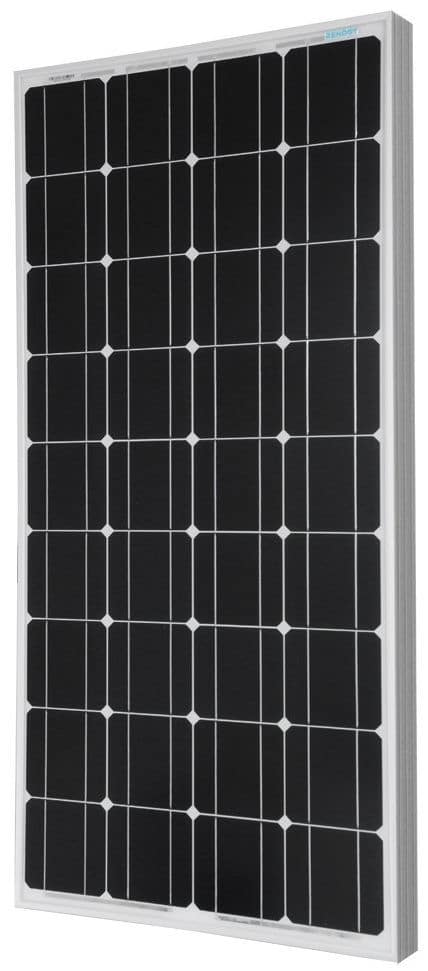
Connecting Solar Panels Together
How to Connect Solar Panels Together
![]() Connecting solar panels together is a simple and effective way of increasing your solar power capabilities. Going green is a great idea, and as the sun is our ultimate power source, it makes sense to utilize this energy to power our homes. As solar power becomes more accessible, more and more homeowners are buying photovoltaic solar panels.
Connecting solar panels together is a simple and effective way of increasing your solar power capabilities. Going green is a great idea, and as the sun is our ultimate power source, it makes sense to utilize this energy to power our homes. As solar power becomes more accessible, more and more homeowners are buying photovoltaic solar panels.
However, these photovoltaic solar panels can be very costly so buying them over time helps to spread the cost. But the problem then becomes how do we connect these extra solar panels together to increase the voltage and power output of what’s already there.
The trick here when connecting solar panels together is to choose a connection method that is going to give you the most energy efficient configuration for your particular requirements.
Connecting solar panels together can seem like a daunting task when you first start to look at how it should be done, but connecting multiple solar panels together is not that hard with a little thought. Wiring solar panels together in either parallel or series combinations to make larger arrays is an often overlooked, yet completely essential part of any well designed solar power system.
There are three basic but very different ways of connecting solar panels together and each connection method is designed for a specific purpose. For example, to produce more output voltage or to produce more current.
Solar photovoltaic panels can be electrically connected together in series to increase the voltage output, or they can be connected together in parallel to increase the output amperage. Solar pv panels can also be wired together in both series and parallel combinations to increase both the output voltage and current to produce a higher wattage array.
Whether you are connecting two or more solar panels, as long as you understand the basic principles of how connecting multiple solar panels together increases power and how each of these wiring methods works, you can easily decide on how to wire your own panels together. After all connecting solar panels together correctly can greatly improve the efficiency of your solar system.
Connecting Solar Panels Together in Series
The first method we will look at for connecting solar panels together is what’s known as “Series Wiring“. The electrical connection of solar panels in series increases the total system output voltage. Series connected solar panels are generally used when you have a grid connected inverter or charge controller that requires 24 volts or more. To series wire the panels together you connect the positive terminal to the negative terminal of each panel until you are left with a single positive and negative connection.
Solar panels in series add up or sum the voltages produced by each individual panel, giving the total output voltage of the array as shown.
Solar Panels in Series of Same Characteristics
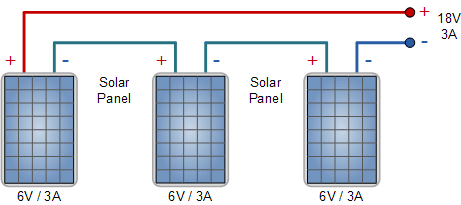
In this method ALL the solar panels are of the same type and power rating. The total voltage output becomes the sum of the voltage output of each panel. Using the same three 6 volt, 3.0 amp panels from above, we can see that when these pv panels are connected together in series, the array will produce an output voltage of 18 Volts (6 + 6 + 6) at 3.0 Amperes, giving 54 Watts (volts x amps) at full sun.
Now lets look at connecting solar panels in series with different nominal voltages but with identical current ratings.
Solar Panels in Series of Different Voltages
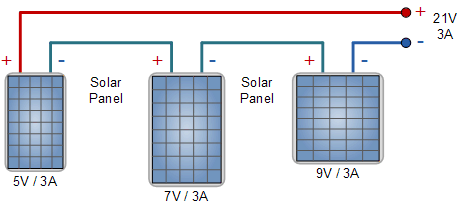
In this method all the solar panels are of different types and power rating but have a common current rating. When they are connected together in series, the array produces 21 volts at 3.0 amps, or 63 watts. Again the output amperage will remain the same as before at 3.0 amps but the voltage output jumps to 21 volts (5 + 7 + 9) .
Finally, lets look at connecting solar panels in series with completely different nominal voltages and different current ratings.
Solar Panels in Series of Different Currents
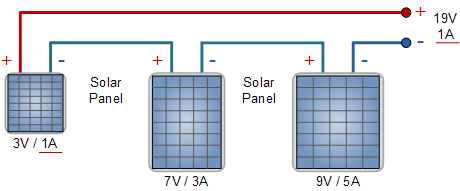
In this method all the solar panels are of different types and power rating. The individual panel voltages will add together as before, but this time the amperage will be limited to the value of the lowest panel in the series string, in this case 1 Ampere. Then the array will produce 19 Volts (3 + 7 + 9) at 1.0 Ampere only, or only 19 watts out of a possible 69 watts available reducing the arrays efficiency.
We can see that the solar panel rated at 9 volts, 5 amps, will only use one fifth or 20% of its maximum current potential reducing its efficiency and wasting money on the purchase of this solar panel. Connecting solar panels in series with different current ratings should only be used provisionally, as the solar panel with the lowest rated current determines the current output of the whole array.
Connecting Solar Panels Together in Parallel
The next method we will look at of connecting solar panels together is what’s known as “Parallel Wiring“. Connecting solar panels together in parallel is used to boost the total system current and is the reverse of the series connection. For parallel connected solar panels you connect all the positive terminals together (positive to positive) and all of the negative terminals together (negative to negative) until you are left with a single positive and negative connection to attach to your regulator and batteries.
When you connect solar panels together in parallel, the total voltage output remains the same as it would for a single panel, but the output current becomes the sum of the output of each panel as shown.
Solar Panels in Parallel of Same Characteristics
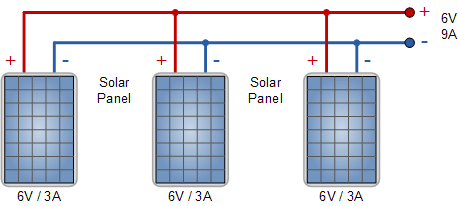
In this method ALL the solar panels are of the same type and power rating. Using the same three 6 Volt, 3.0 Amp panels as above, the total output of the panels, when connected together in parallel, the output voltage still remains at the same value of 6 volts, but the total amperage has now increased to 9.0 Amperes (3 + 3 + 3), producing 54 watts at full sun.
But what if our newly acquired solar panels are non-identical, how will this affect the other panels. We have seen that the currents add together, so no real problem there, just as long as the panel voltages are the same and the output voltage remains constant. Lets look at connecting solar panels in parallel with different nominal voltages and different current ratings.
Solar Panels in Parallel with Different Voltages and Currents
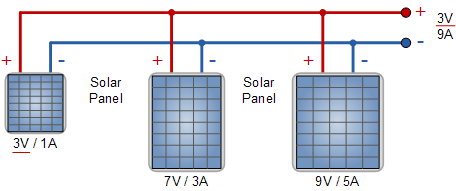
Here the parallel currents add up as before but the voltage adjusts to the lowest value, in this case 3 volts or some voltage value very close to 3 volts. Solar panels must have the same output voltage to be useful in parallel. If one panel has a higher voltage it will supply the load current to the degree that its output voltage drops to that of the lower voltage panel.
We can see that the solar panel rated at 9 volts, 5 amps, will only operate at a maximum voltage of 3 volts as its operation is being influenced by the smaller panel, reducing its efficiency and wasting money on the purchase of this higher power solar panel. Connecting solar panels in parallel with different voltage ratings is not recommended as the solar panel with the lowest rated voltage determines the voltage output of the whole array.
Then when connecting solar panels together in parallel it is important that they ALL have the same nominal voltage value, but it is not necessary that they have the same ampere value.
Connecting Solar Panels Together Summary
Connecting solar panels together to form bigger arrays is not all that complicated. How many series or parallel strings of panels you make up per array depends on what amount of voltage and current you are aiming for. If you are designing a 12 volt battery charging system than parallel wiring is perfect. If you are looking at a higher voltage grid connected system, than you’re probably going to want to go with a series or series-parallel combination depending on the number of solar panels you have.
But for a simple reference in regards to how to connect solar panels together in either parallel or series wiring configurations, just remember that parallel wiring = more amperes, and series wiring = more voltage, and with the right type and combination of solar panels you can power just about any electrical device you may have in your home.
For more information about Connecting Solar Panels Together in either series or parallel combinations, or to obtain more information about the different types of solar panels available, or to explore the advantages and disadvantages of using solar power in your home, then Click Here to order your copy from Amazon today and learn more about designing, wiring and installing off-grid photovoltaic solar electric systems in your home.





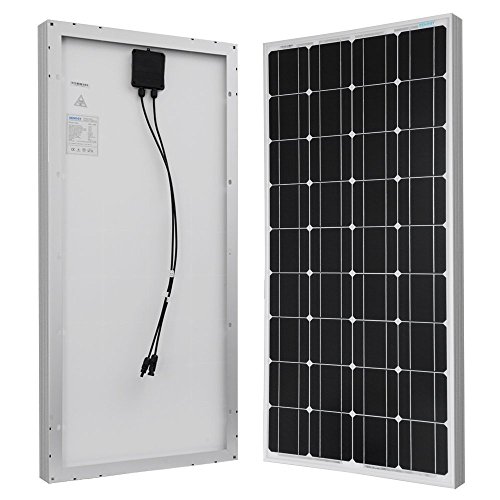





I have 900watts DC brushless self-priming pump on 72volt how many solar panels are needed to run it.
I have read on the web that there should be a diode (blocking reverse flow of current) inserted between PV panels arranged in parallel. I have two small 12v panels (50W + 30W) and I want to chain them in parallel to get 80W @ 12v. Do I have to put a diode somewhere in the wiring between the panels and the battery? Or just between the two panels?
Please see our tutorial about the Photovoltaic Array
Hi I have 4.2 kw controller(ups) and 8 solar panel of 545 watt each , each panel 48 volt , each panel current is 10 amp at its peak Now , i have a question How can i arrange these panels to get max output? If i put 6 panel in series and 2 panel in parallel then connect these together , what is my output ? I require max output Kindly guide me
hello some advice please
i have 4 x 235w panels voc 37v rated 29.5v to power 4 x 130 ah wet battery bank wired series and parallel via a 100amp mppt controller and 24v 6000w invertor would i be better off wiring the panels in parallel or series
thanks for your help and advice
Please I have 2 Panels 270Watts each, connected to a charge controller that charges a 12Volts 200AH battery. I just bought another 2 Panels 300Watts each to be connected together with the existing system. I am thinking if I pair 270W panel with 300 W panel in series before connecting them all in parallel will reduce the loss?
We expect that there would be very little difference in the I-V characteristics between your 270W and 300W panels, as there is such a small difference in wattage, 270W compared to 300W. Thus the Vmp and Voc voltages would be very similar. But the Imp and Isc values would be more different. Then 2 x 270W in one series string, and 2 x 300W in a second series string, with both strings in parallel. That way the voltages would balance out but you would still get different branch currents relating to the wattages.
Currently, I have a 24v system with 24v panels connected in parallel. I want to step down to 12v system without changing the 24v panels, I just want to buy one 12v panel and connect in parallel.
1) What is the effect of 12v panel besides reducing the voltage output of other 24v panels to 12v?
2) Would the 24v panels retain their qualities in case I return to the 24v system after a few years?
1) It does not work like that. Your output would be around 18 volts and your 24 volt panels would be feeding current directly into the smaller 12 volt panel due to such a large mismatch.
2) Probably not, as they would deteriorate over time anyway, and would see your 12 volt panel as the load
Ok.
Can I step the 24v panels down to 12v using my PMT 12v/24v Charge control?
I want to scale down to 12v without throwing my active panels into the bin.
Yes, if the configuration of your charge controller allows it
Hi
If I got 2 x 200w Omega OSP201 Panels connected in series
VOC – 22.2; SCC(A) – 8,6; VMP(v) – 18; Max VMP – 8,11
Connected to 2×180 amp/h batt in Paralel with 2000w Pure Sine inverter and 20 Amp Solar control charger.
Is it the correct way?
Thank you, I’m following
We guess so, if that is how they have been installed
I have 24 x 230 W 37 volt 7.8 Amp panels. In order to fit these panels into my all-in-one EGR 120/240 6000 inverter I have to have a 500 volt max. I believe the only way to meet the 500VOC max requirement, I would need to wire 12 panels in Series and 12 panels in Parallel giving me
12 x 7.8 = 93.6 amps and 37 volts in Parallel + 12 x 37 Volts = 444 Volts and 7.8 Amps in Series Can I combine the 2 Arrays?
12 panels in parallel with 12 panels in series, No.
12 panels in one series string equals 444 volts, and 2 series strings in parallel (12S2P) equals 15.6 (7.8 + 7.8) amperes.
If I connect two 18v panels in series creating 36v output, then connect this array in parallel with two other 36v panels, if one of the 18v series panels is in shade, how will it affect the total output.
The output will be derated as a result of shading as explained in our tutorial about Bypass Diodes
Many thanks appreciate your help.
The connection solar Panels was useful to me, so I am saying thank you, and hope to learn more from you
Hi I have a few 70 volt solar panels and they are very low amperage, I want to Connect to batteries however don’t as yet have an inverter, how are inverters rated and are there inverters that will take high voltages and give 12volt battery Charging Outputs,? I see many 12 volt and 24 volt inverters but cant seem to find one that accepts 70 plus volts input, these panels were sold with LED lights and i was told to connect 3 lights to one panel and they will act as day time down lights but there is no voltage on the light fittings and was told less than 3 lights will be too little and the panels out put would blow them up, so I decided not to operate this way as it sounds unsafe instead I want to use the panels to Charge batteries but the High voltage output is Confusing as other panels I used had 6-12 volt output not 70 volts
It seems you are confused. Solar Charge Controllers, also called Battery Charge Controllers take the voltage and current generated by photovoltaic panel(s), and/or wind turbine generators and produce a standard output voltage of between 12 to 48 volts DC (depending on model) used to charge a single battery or a larger battery bank. The configuration and wattage of any connected pv panel, or array would depend on the DC input characteristics of the contorller.
Inverters take the DC voltage and convert or invert (hence their name) it into AC mains voltage and power, either single-phase 240V or 3-phase for use in the home or to feed the incoming mains power. Thus you would have two different controllers, one to produce the required DC voltage, 12V, 24V, etc. from the panels and another to create the higher mains AC voltage for the home.
Nowadays, there are all-in-one MPPT Solar Regulators or System Voltage Controllers which have both units within one controller. Again, the DC input and power rating of the regulator will decide how you configure your panels, or array.
Thanks for that one last question the panels are 67.9v at 1.07 amps and 72.5 watts how is the best way to wire them all in Parallel, or 3 in series + 3 in series then both sets of 3 in Parallel? I am thinking all 6 in Parallel from my Understanding is there a calculation for the best size Battery or number of Batteries that this will Charge? Thank you for your assistance
If your panels are rated at 70 watts each, and you state you have 6. Then that gives a total of 6 x 70 = 420 watts. This 420 watts is ONLY available during “full sun” conditions, about 4 to 5 hours per day. Thus assuming 4 hours gives 4 x 420 = 1680 watt-hours per day. Since its a DC system, watts are equal to volt-amperes (VA) in this case. Thus you have 1680 VA per day max.
Assuming a 12 volt system, that equates to 1680/12 = 140 amp-hours per day max. Assuming a 50% depth of charge per day, then you would need a 280 Amp-hour battery. That is, your battery discharges to 50% capacity each day, and your panels recharge it during the 4 hours of full sun. Clearly, system losses and efficiency are not considered here.
Thank you,
They will Have full sun and apparently good efficiency in Cloud
I have two 100ah 12v batteries connected in parallel. I have a 100 watt thunderbolt solar kit connected to both batteries. I plan to add another 100w solar panel kit. Should I connect each solar kit to both batteries or connect one kit to a single battery and the other kit to the other battery?
Solar kit implies panel and charge controller. Then it is not advisable to connect two or more charge controllers to the same battery terminals as they will compete against each other and the battery bank may not be charged or protected correctly. Instead connect all the pv panels to the input of one battery charge controller.
not connect in paralel,you just connect your batteris in series and connect the pannels in series in order to increase the current,your system will run perfectly
Incorrect information. Series connection increases voltage, not current. He has a 12 volt system, not a 24 volt system
Hi there,I have 2x 330w in parallel with 36v,20a output.Can I run this through a 24v, 20amp , 440 watt voltage inverter/dropper/converter??
What is the DC input specifications of your inverter/dropper/converter
Please bear with me, I man not a total newby, but I do still have a lot to learn about this…
I am changing / adding to my RV solar system. It currently has a single panel that I think is 175 watt with a 30 amp PWM controller and 2 12-volt 100 AH RV batteries that were not properly maintained and need to be replaced. Controller and batteries will get changed out, as I change/add panels on the roof and upgrade the wiring to the controllers and battery bank.
I want to build the system so I can add to it in equal increments as I discover just how much power I need and if needs change. (Unit not yet in my possession so I don’t know exactly how I will be consuming power.)
My original plan was to build the system with three 200-watt panels and a 60 amp MPPT controller (or 2 panels and a 40 amp controller), keeping everything balanced and add to the system in these increments. I have plenty of room for controllers and batteries, with a fair amount of room on the roof and plan on using Tilt Brackets to maximize collector exposure
This is where I fall down…. Panels in Series or Parallel? Parallel would give me 27 volts. Series would give me 81 volts. I would really like to stay with 12-volt system so I don’t have to change anything else in the RV, Can this be done with the higher voltage / lower current feeds from the panels? Will the controllers be able to take the higher voltage and adjust accordingly or should I go with the lower voltage and higher current? Also, I don’t yet know at what my Charger/Inverter is rated at so I may have to change that as well.
At this point the only thing I have purchased is batteries that were removed from my previous RV’s system. These are FLA 6-volt GC2 batteries that were connected in series/parallel giving me 12 volts, 420 AH (allowing for a 50% draw-down), giving me 210 AH. I will eventually switch over to Li Batteries and add additional cells as the system increases
I am considering 200 Watt panels, up to 2000 watts MAX. The manufacturers spec’s on these panels have a Voc of 27 volts, Short Circuit Current of 9.66 amps.
In your opinion, would I be better to consider more panels with a lower wattage (100 watts) or continue with the 200 watt panels?
This is a large RV and mostly Boondocking / Dry Camping expected for 1 night stays and up to 2 weeks or more. (I have a portable generator, but would prefer to use it only when necessary).
The size of chosen panels would depend on the available installation space as 2 x 100W panels would take up about 40% more area than one single 200W panel. The configuration of your 2kW array would depend on the DC input characteristics of your charge controller. Higher voltage and lower current would be the preferred option as lower current means smaller diameter cables. Your 60 amp MPPT controller may have a DC input voltage of 150VDC, then your panels Voc of 27 volts would mean 5 panels in one series string (5 x 27 = 135V) and two parallel branches (5S2P) giving a Isc of 19.32 amperes (2 x 9.66) for your 2kW (10 x 200W) array. Clearly, you would need to consult your charge controllers specifications first.
I have 12 – 250 Watt solar pannels. Voc 37.6 and Rated current 8.27 Amps
I have a 80A MPPT solar charge controller wit a Max PV input 2000W (Max. PV Array OV).
I Have 24V 3KVA, with input voltage 65-140VAC/95-140VAC.
Wich would be the ideal way to set up the solar panels to produce the most for my battey bulk and inverter?
We assume you have bought the solar items you have bought for a reason because you have some knowledge or have been previously advised. If not or you have no idea what you are doing but want us to tell you.
Clearly, a 250W panel is for 24 volt battery charging. Thus 2000/24 = 83 amperes as you have stated. Then you need a 48 volt system with 6 branches of two panels per string. This would give a maximum array Voc of 75.2 volts, and a maximum array current of 50 amperes.
I have two panel 545 watt and one panel 150 watt l have 2.8 kva inverter 24watt how I connect these panel serial or parallel .
Clearly with such a large mismatch between panels, you cannot use the 150W panel with the two 545W panels.
All is spoken and all is said ,but I just want to know we have six 150watts panels,a 60A charge controller and 4 200A batteries which right way would you recommend us to use in connecting the panels and the batteries /which installation style will give something that is better that we may be able to use a 240-300 volts inverter and 60 12volts bulbs
You have 6 x 150 watt panels. Then you have a total of 900 watts maximum at full sun, no matter how you connect them. 150W panels are for charging 12 volt batteries, thus their Vmp is usually about 18 volts. 3 x 18 = 54 volts plus 25% for Voc equals about 68 volts. If your 60A charge controller can handle a maximum DC input of 68 volts, then 3 panels in a series string, and 2 parallel branches (3S2P). If not, 2S3P. Your 12 volt light bulbs will require a 12 volt supply from the 12 volt batteries. Then your 4 batteries are connected in parallel.
If both solar panels (120w and 200w) have a charge controller fitted do I need to remove one of them to charge two 12v 105A batteries
Each panel can be used to charge a single battery. But as the characteristics of each panel is different, each battery will charge at a different rate.
or join the the wiring below the two controllers to the battery bank . . . in this way should one panel, controller or wiring fail, the other panel will carry the load. ???
Was good please
Hi
I have 8 solar panel of 545 watt each , each panel 48 volt , each panel current is 10 amp at its peak
Now , i have a question
How can i arrange these panels to get max output?
If i put 6 panel in series and 2 panel in parallel then connect these together , what is my output ?
I require max output
Kindly guide me
8 x 545 watts is equal to 4360 watts maximum at full sun, no matter how you configure them.
I have 3x 215 watt panels victron.. using a 50amp victron controller i will be fusing a 50amp from controller to battery..can you tell me do i need to fuse each panel to controller or can i just use one fuse ..which size fuse ..plus what would you recommend series or parallel..many thanks.
215 watt panels are generally for 24v systems, thus have an output voltage of around 36 volts. 215w/36v equals about 6 Amperes. 3 in series equals about 108 volts (check panel specs for max Voc). If you controller can handle upto 120VDC input go series at 6 amps. If not 3 in parallel at 36 volts, 18 amps at full sun. For series, obviously one fuse. For parallel, one fuse per branch (panel) if you want, or just one for the whole set.
If I have two solar pannes of same voltage(18v×2) but different amperes(80w,120w) and I use two different charge controller on one battery of 150AH.will my connection add up as expected?
Probably not, The two charge controllers will oppose each other.